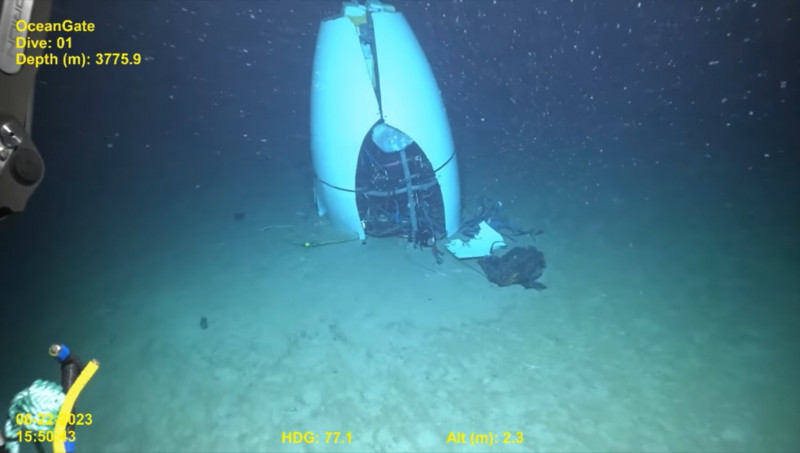On June 18, 2023, the Titan submersible, operated by OceanGate, imploded during a Titanic wreck expedition in the North Atlantic. The incident resulted in the deaths of all five passengers: OceanGate CEO Stockton Rush, Titanic expert Paul-Henri Nargeolet, British businessman Hamish Harding, and Pakistani-British businessman Shahzada Dawood with his son Suleman. The implosion occurred due to the immense pressure at extreme depths. The event raised concerns about the safety standards and regulatory oversight of submersible expeditions, particularly in the context of deep-sea tourism.
April 1912: Sinking of the Titanic
In April 1912, the British ocean liner Titanic sank in the North Atlantic Ocean after colliding with an iceberg, resulting in over 1,500 deaths.
1985: Discovery of the Titanic Wreck
In 1985, Robert Ballard located the wreck of the Titanic 320 nautical miles off the coast of Newfoundland, at a depth of about 3,810 meters.
1993: U.S. Passenger Vessel Safety Act
The U.S. Passenger Vessel Safety Act of 1993 was mentioned by Rush as needlessly prioritizing passenger safety over commercial innovation.
2009: OceanGate Founded
In 2009, OceanGate, the company that would later operate the Titan submersible, was founded by Stockton Rush and Guillermo Söhnlein.
2010: OceanGate Begins Commercial Submersible Operations
Starting in 2010, OceanGate began transporting paying customers in leased commercial submersibles off the coasts of California, in the Gulf of Mexico, and in the Atlantic Ocean.
2012: Titanic Wreck Visits Reach 140 People
By 2012, 140 people had visited the wreck site of the Titanic since its discovery in 1985.
2016: OceanGate's Dive to the Wreck of Andrea Doria
In 2016, OceanGate conducted a dive to the wreck of Andrea Doria aboard their submersible Cyclops 1.
March 2018: Boeing Engineer Warns Rush of Significant Failure Risk
In March 2018, Mark Negley, one of Boeing's engineers involved in the preliminary designs, emailed Stockton Rush directly stating that the Titan design was at "high risk of a significant failure" at or before reaching 4,000 meters, indicating that they did not have any safety margin.
March 2018: McCallum Warns Rush of Safety Risks
In March 2018, Rob McCallum emailed Rush to warn him that he was potentially risking his clients' safety and advised against using the submersible for commercial purposes until it had been independently tested and classified. McCallum's warnings prompted OceanGate's lawyers to threaten him with legal action.
2018: Lochridge Documents Safety Concerns About Titan
In 2018, OceanGate's director of marine operations, David Lochridge, documented safety concerns about the Titan, urging assessment and certification by the American Bureau of Shipping, but OceanGate refused. He also questioned the viewport's depth rating and the effectiveness of RTM.
2018: Marine Technology Society Expresses Concern Over Titan Development
Later in 2018, the Marine Technology Society drafted a letter to Rush expressing "unanimous concern regarding the development of 'TITAN' and the planned Titanic Expedition", indicating that the "current experimental approach ... could result in negative outcomes.
2019: Lloyd's Register Refuses to Class Titan
In 2019, Lloyd's Register, a ship classification society, refused OceanGate's request to classify the Titan submersible.
2019: Rush Comments on Titanic's Media Appeal
In 2019, Stockton Rush told Smithsonian magazine that the Titanic was the only wreck everyone knew and would name underwater, highlighting its appeal for media attention.
2019: Rush Described as a 'Daredevil Inventor'
In a 2019 Smithsonian magazine article, Stockton Rush was described as a "daredevil inventor".
2020: Titan Hull Downgraded After Cyclic Fatigue Signs
In 2020, the Titan's hull, originally designed to reach 4,000 m below sea level, was downgraded to a depth rating of 3,000 m after showing signs of cyclic fatigue.
2021: Rush Patents Real-Time Monitoring System
In 2021, Stockton Rush patented a proprietary real-time monitoring system (RTM) that OceanGate claimed was integrated into the Titan for safety, using acoustic sensors and strain gauges.
2021: Titan Hull Constructed After Previous Cracking
In 2021, a new hull was constructed for the Titan after a previous hull had cracked after 50 submersion dives. Engineers had warned against using the lifting rings but were ignored.
2021: Titan Hull Repaired or Rebuilt
In 2021, the hull of the Titan submersible was either repaired or rebuilt following the downgrade in 2020 due to cyclic fatigue.
2021: Rush Admits Breaking Rules in Titan's Construction
In a 2021 interview, Stockton Rush admitted to breaking some rules in the construction of the Titan, justifying it with logic and good engineering.
2021: OceanGate Conducts Titanic 'Missions'
OceanGate conducted five 'missions' to the wreck of the Titanic in the middle of 2021 as part of multi-day excursions.
July 15, 2022: Extreme spike noted during ascent of Dive 80
On July 15, 2022, during Dive 80, an extreme spike on one of the acoustic sensors was noted during the ascent to the surface. The loud bang was reported by the passengers during this dive and coincided with anomalous strain readings. The analysis also contains details of the RTM system which OceanGate claimed would provide "early warning detection".
July 2022: Titan experiences loud acoustic event during ascent
On July 15, 2022 (dive 80), the Titan submersible experienced a "loud acoustic event" while ascending, which was heard by passengers and detected by its real-time monitoring system (RTM). Strain gauge data later revealed a permanent shift in the hull's strain response following this event.
November 2022: OceanGate reports battery problems and damage to external components
According to November 2022 court filings, OceanGate reported that during a 2022 dive, the Titan submersible experienced battery problems and had to be manually attached to a lifting platform, resulting in damage to its external components.
December 2022: David Pogue's report questions Titan's safety
In December 2022, David Pogue, aboard the surface ship, reported for CBS News Sunday Morning, questioning the safety of the Titan submersible after it became lost and failed to locate the Titanic wreck during a dive. Pogue highlighted the "MacGyvery jerry-rigged-ness" of the submersible, noting the use of a $30 Logitech F710 wireless game controller for steering and construction pipes as ballast.
2022: Ross Kemp Documentary Cancelled Due to Safety Concerns
In 2022, British actor Ross Kemp's plan to dive to the Titanic wreck in the Titan for a Sky History documentary was cancelled after the production company deemed the submersible unsafe.
2022: Passengers Sign Waiver Acknowledging Risks
In 2022, passengers entering the Titan signed a waiver acknowledging it was an "experimental" vessel that could result in injury, disability, emotional trauma, or death.
2022: OceanGate Continues Titanic 'Missions'
OceanGate continued its 'missions' to the wreck of the Titanic with five excursions in the middle of 2022.
June 2023: Quote by Sean Leet
In June 2023, Sean Leet spoke with CNN, offering insights or comments related to the Titan submersible incident. The specific content of Leet's statement is not detailed.
June 2023: Estimated costs of search and rescue operations
In June 2023, a Washington Post analysis estimated the U.S. Coast Guard operations' costs alone at approximately USD$1.2 million as of June 23, 2023. Deploying a Lockheed CP-140 Aurora aircraft and 341 sonobuoys cost Canadian taxpayers at least CAD$3 million.
June 2023: U.S. Coast Guard notified of missing submersible
In June 2023, the Titan submersible was expected to resurface at 4:30 p.m. (19:00 UTC). At 7:10 p.m. (21:40 UTC), the U.S. Coast Guard was notified that the vessel was missing. The Navy reviewed its acoustic data and passed information about a possible implosion event to the Coast Guard. The Titan had up to 96 hours of breathable air supply, which would have expired on June 22, 2023, if the submersible had remained intact.
June 2023: Titan Submersible Implodes During Titanic Expedition
In June 2023, the Titan submersible, operated by OceanGate, imploded during an expedition to view the wreck of the Titanic in the North Atlantic Ocean off the coast of Newfoundland, Canada. Stockton Rush, Paul-Henri Nargeolet, Hamish Harding, Shahzada Dawood, and Suleman Dawood were aboard.
June 2023: Pogue's report goes viral after Titan's loss of contact
In June 2023, the report by David Pogue from December 2022, questioning the safety of the Titan submersible, went viral on social media after the submersible lost contact with its support ship.
June 2023: Titan's "Mission 5" departs from St. John's, Newfoundland
On June 16, 2023, at 9:31 a.m. local time (12:01 UTC), the Titan submersible's expedition to the Titanic wreck, dubbed "Mission 5," departed from St. John's, Newfoundland, aboard the MV Polar Prince. Hamish Harding noted that this mission was likely the first and only crewed mission to Titanic in 2023 due to the severe winter, with operations scheduled to begin around 4:00 a.m. EDT (08:00 UTC) on June 17th.
June 2023: Search and rescue efforts begin
On June 20, 2023, the pipe-laying ship Deep Energy, operated by TechnipFMC, arrived on site with ROVs and other equipment. The U.S. Coast Guard had searched 10,000 square miles. The New York Air National Guard's 106th Rescue Wing joined the search and rescue mission with a HC-130J.
June 2023: New mission underway to the Titan debris field
On June 23, 2023, Pelagic Research Services confirmed that a new mission to the Titan debris field was underway. The Odysseus 6k ROV took one hour to reach the site to continue searching and documenting debris.
2023: Associates Disclaim Involvement with Titan Project
Following the disappearance of the Titan in 2023, the University of Washington, Boeing, and NASA disclaimed involvement with the design, engineering, or testing of the submersible.
2023: Vanity Fair Recounts Near Disaster on 2016 Expedition
In 2023, Vanity Fair recounted a near disaster that occurred during OceanGate's 2016 expedition to the wreck of Andrea Doria.
2023: Titan Implodes During Fifth Mission of 2023
In 2023, the Titan imploded during its fifth mission of the year; the previous four missions did not get close to the Titanic due to rough weather.
2023: Jay Bloom declines discounted tickets due to safety concerns
In early 2023, Rush offered American businessman Jay Bloom two discounted tickets at $150,000 each for the Titan submersible excursion, originally scheduled for May but delayed to June due to weather. Bloom declined due to safety concerns, despite Rush claiming it was "safer than crossing the street."
2023: Titan's Final Dive in 2023
OceanGate had planned multiple dives to the Titanic's wreck in 2023, but the dive during which Titan was destroyed was the only one launched that year.
2023: Simulations suggest rapid implosion and instantaneous death
Simulations developed in 2023 suggest that due to the immense pressure (nearly 400 atm, or 6,000 psi), the implosion of the Titan submersible likely took only a few milliseconds, resulting in the instantaneous death of the occupants.
August 2024: Nargeolet's family sues OceanGate for wrongful death
In August 2024, the family of Nargeolet sued OceanGate for wrongful death, seeking $50 million in damages. The lawsuit claimed that OceanGate and Stockton Rush failed to disclose the condition, durability, composition, and components of the Titan submersible and that many flaws were purposely concealed.
September 2024: Marine Board of Investigation public hearings held
From September 16–27, 2024, the public hearings for the Marine Board of Investigation were held in Charleston, South Carolina, under the joint authority of the NTSB and the US Coast Guard. Testimony was livestreamed on YouTube, and over 100 exhibits were provided on the MBI website. Key observations included cost over safety concerns and OceanGate's refusal to address safety issues. 25 witnesses gave testimony during the MBI.
September 2024: Contractor testifies about crew awareness before implosion
In September 2024, Tym Catterson, an OceanGate contractor, testified that there was no indication the crew was aware of any problems before the implosion. The last communication from Titan indicated they dropped two weights, which was apparently routine, and the last automatic ping was received six seconds later.
September 2024: DNA profiles for the five victims identified
In September 2024, during a public hearing by the Marine Board of Investigation, the USCG confirmed that the Armed Forces DNA Identification Laboratory positively identified DNA profiles for the five victims. Previously, on June 28, 2023, the Horizon Arctic returned to St. John's Harbour with the remains of the Titan recovered from the debris field.
2024: James Cameron comments on the potential for a warning system alert
In a 2024 interview with 60 Minutes Australia, James Cameron suggested that the Titan submersible's early warning system likely alerted the passengers to an impending delamination of the hull, noting their attempt to ascend by dropping ascent weights. He also commented on the limitations faced by parties attempting to reach the last known position.
January 2025: Case initially requested to move to federal court
In January 2025, there was an initial request to move the case related to Nargeolet's family lawsuit against OceanGate to a federal court. However, a federal judge moved the case back to a state court by February 2025, and the lawsuit remains ongoing.
August 5, 2025: Marine Board of Investigation releases report, blaming OceanGate
On August 5, 2025, the Marine Board of Investigation released its report, predominantly blaming OceanGate, stating that the Titan submersible accident was "preventable." The report cited flawed safety practices, including using an uncertified carbon fiber hull and neglecting maintenance. The board issued 17 safety recommendations and concluded that the loss of life was avoidable through proper oversight. The report also indicated Stockton Rush exhibited negligence.
Mentioned in this timeline
CBS is a major American commercial broadcast television and radio...
California is a U S state on the Pacific Coast...
CNN Cable News Network is a multinational news organization founded...
NASA the National Aeronautics and Space Administration is an independent...

The Boeing Company is a multinational corporation and one of...

News encompasses information about current events disseminated through various media...
Trending
18 days ago Mack Hollins' Halloween Bishop Costume Causes Frenzy Before Patriots-Browns Game
8 months ago LCDLF All-Stars Drama: Gianmarco Demands Action, Niurka Influences, Julia Makes Choice
2 hours ago Chris Matthews blames Democrats' 'snobbery' for alienating working-class voters and fueling Trump's support.

6 months ago Jasmine Crockett: Republicans' Shocking Messages Fuel Trump Concerns, Acosta's Jailed Fears.

1 month ago SpaceX Starship Flight 11 Megarocket Launch: Moon Race Implications and Starbase Operations

1 month ago Earthquake of Magnitude 5.7 Strikes Ethiopia, Felt East of Wik'ro
Popular

Nancy Pelosi is a prominent American politician notably serving as...

Chuck Schumer is the senior United States Senator from New...

Bernie Sanders is a prominent American politician currently serving as...
Nicholas J Fuentes is a far-right political commentator and activist...

Candace Owens is an American political commentator and author known...

William Franklin Graham III commonly known as Franklin Graham is...
